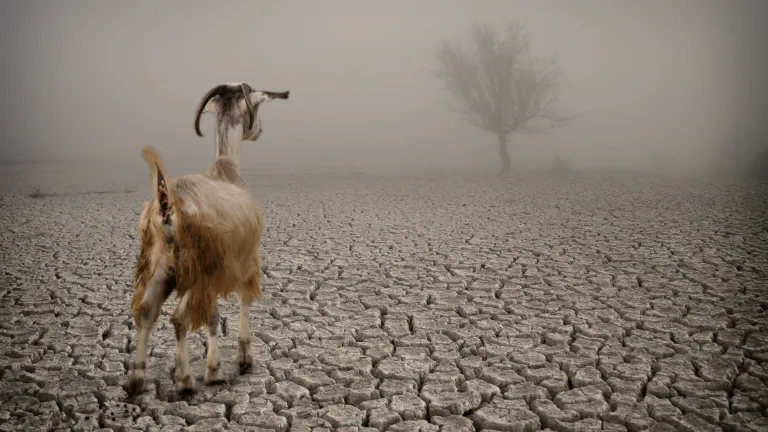What Does the Day of Atonement Have to Do With Jesus Christ?

What does an ancient Old Testament ceremony involving two goats have to do with our Lord and Savior, Jesus Christ? Furthermore, are Christians to fast on this Holy Day?
One of the more mysterious chapters in the Old Testament is Leviticus 16, concerning the 10th day of the Hebrew seventh month, the Day of Atonement (see Leviticus 23:26-32). Chapter 16 discusses a series of animal offerings for this occasion, including that of two goats with roles determined by lot, and Israel’s high priest entering the Holy of Holies of the physical tabernacle. It also commands a fast on this day.
Ultimately, Leviticus 16 points to the dual roles that God our Father gave to Jesus Christ to become both our High Priest and ultimate sacrifice for our sins, as well as pointing to the complete removal of the source of sin.
A sinless High Priest
We read in Leviticus 16:4 that ancient Israel’s high priest was to bathe himself on this occasion, then put on his priestly attire. In Leviticus 16:5-6 we read that he was to offer a bull as a sin offering for himself and his own family. This is significant in that it shows that no human being is without sin, not even the earthly high priest (see Hebrews 5:1-3). As a man, he too needed forgiveness; he needed to be washed clean so that he could perform his priestly duties.
But Jesus Christ, our true High Priest sent from God, never needed forgiveness (Hebrews 3:1; Hebrews 7:26-28). He “was in all points tempted as we are, yet without sin” (Hebrews 4:15). Satan could never plant any of his evil nature in Him (John 14:30).
Israel’s high priest was to wear “the holy linen tunic and the linen trousers,” and “be girded with the linen sash” (Leviticus 16:4). This is similar to the clothing Christ wore when He appeared to the apostle John in a vision. Jesus was seen standing “in the midst of the seven lampstands . . . clothed with a garment down to the feet and girded about the chest with a golden band” (Revelation 1:13). Some commentators note that the word translated “garment” here denotes priestly attire.
Two goats—one for the Lord, one for another
Next, the high priest was to deal with the two goats. One would represent the Lord and the other, often called the “scapegoat,” would represent something else. He cast lots to determine which each would represent (Leviticus 16:8).
Note Leviticus 16:9: “And Aaron shall bring the goat on which the Lord’s lot fell, and offer it as a sin offering.” This goat, which represented the Lord, was sacrificed as a sin offering. It clearly stood for Jesus Christ, the ultimate sin offering who was slain for the sins of the whole world.
Since two goats were involved, many think both goats were to represent the Lord. But notice the contrast here in Leviticus 16:8: “One lot for the Lord and the other lot for the scapegoat”—or for Azazel, some Bible versions leaving the Hebrew word here untranslated. Clearly, only one goat was to represent the Lord. The other goat was not.
Note Leviticus 16:10: “But the goat on which the lot fell to be the scapegoat [or Azazel] shall be presented alive before the Lord, to make atonement upon it, and to let it go as the scapegoat into the wilderness.”
So this goat was not to be killed as the goat for the Lord was. The high priest was to “lay both hands on the head of the live goat and confess over it all the wickedness and rebellion of the Israelites—all their sins—and put them on the goat’s head. He shall send the goat away into the wilderness in the care of someone appointed for the task. The goat will carry on itself all their sins to a remote place; and the man shall release it in the wilderness” (Leviticus 16:21-22, New International Version, emphasis added throughout).
This sending away into the desert is part of the reason for translating Azazel as scapegoat, or goat that escapes. But many scholars identify Azazel as the name of a demon inhabiting the wilderness.
It stands to reason that Azazel is one in stark contrast to the Lord—indeed, the ultimate enemy Satan the devil.
Christ bore our sins to the cross in order to pay the ransom price for them through His own blood (and the resurrected Christ was portrayed by the high priest presenting the slain goat’s blood before God). In contrast, Satan bears the blame for sin as he was the first to lead mankind astray in the Garden of Eden and continues to deceive humanity today (2 Corinthians 11:3). And he is the tempter (Matthew 4:3)—enticing the world into sin.
The high priest placing sins on the live goat and having it driven away parallels the future of Satan and his demons at Christ’s return. They will be removed at the outset of Jesus’ reign over the nations, as John describes in Revelation 20:1-3:
“Then I saw an angel coming down from heaven, having the key to the bottomless pit and a great chain in his hand. He laid hold of the dragon, that serpent of old, who is the Devil and Satan, and bound him for a thousand years; and he cast him into the bottomless pit, and shut him up, and set a seal on him, so that he should deceive the nations no more till the thousand years were finished . . .”
Jesus died for our sins. But Satan will bear blame for his role in our sins and be banished. And with the instigator of sin removed, the world will more easily be led to atonement—“at-one-ment,” meaning to be at one—with God.
Consider that if the live goat represented the resurrected Christ, then this would mean the sins Christ bore on the cross are placed back onto Him after His resurrection. Clearly this is not what happened.
And there is another distinction scholars have noted. We see that the Azazel goat was to be driven from the camp of Israel. In other words, this goat was not to dwell with humanity again. This banishment fits with Satan’s future. Yet it is the exact opposite of the role of Jesus Christ, who has promised to be with His people forever. “For He Himself has said, ‘I will never leave you nor forsake you’” (Hebrews 13:5).
Jesus as High Priest and perfect sacrifice for all mankind
In Leviticus 16:17 we read of Israel’s high priest: “There shall be no man in the tabernacle of meeting when he goes in to make atonement in the Holy Place.” The high priest did this atonement work alone. Christ, too, did His work alone. Earlier, His disciples “all forsook Him and fled,” Mark 14:50. Indeed, He felt so totally alone that he cried out to His Father: “My God, My God, why have You forsaken Me?” (Matthew 27:46). At that point, Jesus alone bore the sins of all humanity.
And in His awesome sacrifice Jesus fulfilled the sacrificial system God gave to Israel (see Hebrews 9:13-14). The animal sacrifices on Atonement and those at other times ultimately pointed to the coming sacrifice of Jesus Christ.
Hebrews 10:4 states: “Because it is impossible for the blood of bulls and goats to take away sins.” And in Hebrews 10:8-10 we read: “First he said, ‘Sacrifices and offerings, burnt offerings and sin offerings you did not desire, nor were you pleased with them’—though they were offered in accordance with the law. Then he said, ‘Here I am, I have come to do your will.’ He sets aside the first to establish the second. And by that will, we have been made holy through the sacrifice of the body of Jesus Christ once for all” (NIV, 1984).
These verses plainly state that the sacrificial system is not necessary today—that we have the one sacrifice for us we need, that of Jesus Christ. Indeed, to His Father He “appeared to put away sin by the sacrifice of Himself” (Hebrews 9:26). This one-time sacrifice of our great High Priest once and for all is more than sufficient to pay for the sins of all of humanity.
Today, however, Jesus’ sacrifice and priestly work is properly accepted with repentance by only a few. But after He returns, all mankind will come to truly understand what He has done for us.
It’s interesting to note that Jesus’ sacrifice is portrayed vividly in the spring feast of Passover, the day on which He actually died, as well as in this fall Holy Day of Atonement. Our free study guide God’s Holy Day Plan points out: “The Day of Atonement and Passover both teach us about the forgiveness of sin and our reconciliation with God through Christ’s sacrifice. However, Passover concerns the redemption of the firstborn and thus applies most directly to Christians whom God has called in this age, while Atonement carries universal implications.”
Christ’s sacrifice and intercessory work as our High Priest allows us to come before God’s throne continually (see Hebrews 4:14-16)—to enter the Holy of Holies in a spiritual sense—and cast Satan out of our lives now. But this will not be experienced by all Israel and the world at large until widespread repentance following Christ’s second coming and the full banishment of Satan from the world scene (as pictured in the fall feasts).
An observance to keep today—with fasting
In Leviticus 23:27 God commanded ancient Israel: “This shall be a statute forever for you: In the seventh month, on the tenth day of the month [i.e., Atonement], you shall afflict your souls, and do no work at all” (see also Leviticus 23:31; Leviticus 23:26-32). This meant they were to fast—to go without food and water—for a period of 24 hours.
Psalm 35:13 says that King David humbled himself with fasting. The word “humbled” is anah in the Hebrew, which is the same word we find in Leviticus 23:27, translated as afflict. Thus, to afflict one’s soul or being refers to the humbling process we go through when we fast. This day of fasting is for the purpose of humbling ourselves before God in a repentant and obedient frame of mind—to practice self-control with God’s help as we seek Him.
This time of fasting is not for the purpose of appearing to other people to be righteous (Matthew 6:16). Fasting as a display to others is hypocritical and vain. Scripture tells us that we are to fast only for the glory of God (Zechariah 7:5).
Fasting typifies the kind of humble, repentant and obedient attitude we as Christians must have. Christ promised that in the ages following His first coming, His disciples would fast on occasion (Matthew 9:15).
In fact the Day of Atonement is still mentioned long after Christ’s death and resurrection as “the Fast” in Acts 27:9. Paul and his gentile companion Luke were still observing this Holy Day by fasting. Many biblical commentaries acknowledge that verse is indeed referring to the Day of Atonement. Certainly, if Paul, the apostle to the gentiles, observed this day, then Christians today should follow his example (1 Corinthians 11:1) and observe this day as well.
Leviticus 16 is a remarkable chapter in portraying two of the major roles of Jesus Christ. The Old Testament high priest typified the role of Christ as our ultimate High Priest. And the goat which was slaughtered was a type of the one great sacrifice our loving Father gave for the entire world, so that, in the words of John 3:16, “whoever believes in Him should not perish but have everlasting life.”






